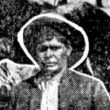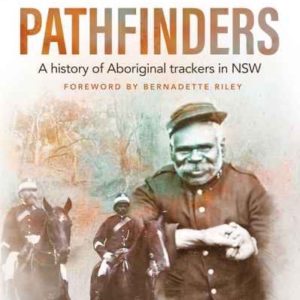Loading map...

George Sharpley of Goodooga was born in 1863. The names of his parents are unknown, but it is likely that he had a white father and an Aboriginal mother. His totem was pademelon and he belonged to the Kubbi section. Sharpley was probably an initiated man as he was asked in 1897 to carry a message stick inviting an Aboriginal man named Nanee and others from Goodooga to attend a “big corroboree” on the Cuttaburra River in south-west Queensland approximately 150km away [ref]Mathews 1898: 142[/ref].
Sharpley worked as the tracker at Goodooga Police Station continuously from January 1884 to November 1912, although he was sometimes asked to work further west. Once at Brewarrina when trying to located stolen foodstuffs, Sharpley’s attention was drawn by “innumerable ants” on the ground. He studied them for a while and noticed they were carrying grains of sugar. The trail of ants led Sharpley directly to the food [ref]Wingham Chronicle and Manning River Observer 2 November 1954: 3.[/ref].
After leaving the police force, Sharpley seems to have remained in Goodooga. In 1936, his voter registration gave his residence as Goodooga [ref]1936 Electoral Roll, Commonwealth – Gwydir, State – Castlereagh, subdivision of Collarenebri: 24[/ref]. And he was living in the Goodooga police paddock (probably the same place he lived when he was a tracker) on 3 April 1942 when he passed away. He was buried the following day in Goodooga Cemetery [ref][1] DC of George Sharpley 1942/011269.[/ref]. There are no known descendants, although the surname is well known at nearby places such as Dirranbandi and Angledool. George may have been related to Albert Sharpley who was born in Queensland in 1872 and passed away at Dirranbandi in 1952 [ref]DC of Albert Sharpley 1952/31343406.[/ref].

 This website explores the history of Aboriginal trackers in NSW from 1862 when the current NSW Police Force was established through to 1973 when the last tracker, Norman Walford, retired. You can read about the lives of individual trackers and some of the incredible tracking feats they...
This website explores the history of Aboriginal trackers in NSW from 1862 when the current NSW Police Force was established through to 1973 when the last tracker, Norman Walford, retired. You can read about the lives of individual trackers and some of the incredible tracking feats they...

There were over 200 NSW police stations that employed Aboriginal trackers between 1862 and 1973. Many were concentrated in the central-west and north-west of the state, the agricultural and pastoral heartland of NSW. This is because one of the main jobs of trackers was to pursue sheep, cattle and horse thieves. Trackers sometimes lived in small huts out the back...
Learn More ►
Pathfinders book Pathfinders, A history of Aboriginal trackers in NSW, written by Dr Michael Bennett and published by NewSouth, is now available from all good bookstores. Click on the link below to order your copy. https://www.abbeys.com.au/book/pathfinders-a-history-of-aboriginal-trackers-in-nsw.do Early History Since the beginning of the colony, government agencies, explorers, surveyors and members of the general public called upon the tracking...
Learn More ►